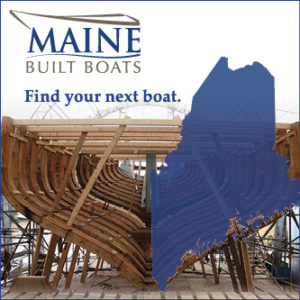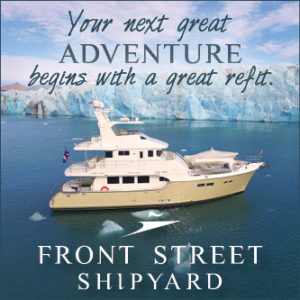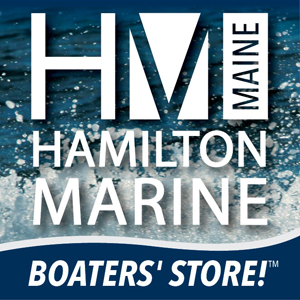My learning curve has not decreased at all since buying Jonesport Shipyard a year and three months ago. It is a good thing that I love a challenge.
I have been around boat yards since I was little. I was fortunate to have grown up 100 yards away from Allan H. Vaitses’ yard in Mattapoisett, Massachusetts. He opened the shop sometime in the early 1950s when he left his partnership with Fred Brownell. They had both worked at Burr’s Brothers in Mattapoisett before setting up their own shop for building boats. However, Fred wanted to build power boats and Allan wanted to build sailboats, so they went their separate ways. Most everyone knows the Brownell’s because Fred was the inventor of the jack-stands and the hydraulic boat hauling trailers. His yard was a little over a mile from the town dock, which had a launching ramp, and he looked for a way to get the boats to his shop the easiest way possible. I believe the first vehicle they used to haul the trailer was an airport tractor, but then they switched to big diesel trucks. Fred was always looking to better his equipment and others were looking to copy what he had done. Unfortunately, Brownell’s have sold most aspects of their father’s business. I believe the jack stands and the boat hauling in southern New England is still owned by them. However, their boat yard and the building of the trailers has been sold.
Getting back to Vaitses’ yard, I remember the small shed he started with, sort of a gambrel roof barn, with room for maybe a 45-footer. It had a cement floor and was heated with wood. There was a back room for storage and some bigger power tools and the outhouse was way out back filled with old boating magazines. Probably in the early ‘60s he added a bigger building next to the original one and maybe in the late ‘60s he erected another shop down back. I remember the night a fire started in the back shop, but fortunately Allan was letting an Alaskan, who was building a sailboat there, stay in his truck camper beside that building. He heard the fire, called it in and there was only slight damage. Today, there is nothing left of the yard, sold for a development.
When I first started going over to the yard with my father, Allan was building wooden sailboats. I believe I once met L. Francis Herreshoff there as they were building one of his designs. The other well-known designer that was frequently there was C. Raymond Hunt, the designer of the deep-V hull, which increased the performance of powerboats. Hunt also designed sailboats and one of them was the International 210. He had designed a radical version of this boat, which Allan had built. This boat ended up down at Allan’s house, where it might still be if it had not gone back to nature. Unfortunately, I never asked Allan about what was radical about it or how it sailed.
Allan built in all sorts of mediums: wood, traditional or cold moulded, fiberglass and even cement. Believe it or not, he did not like wood as a boatbuilding material. He built sailboats, power boats and even a Hickman Sea Slide. One boat I remember was the 60+-foot power boat ACTIVE, which used to hail from Newport, Rhode Island. I remember seeing her in Newport when I was at the America’s Cup in 1980, and I have been trying to find out where she is but have yet to locate her.
I used to go over to the yard and watch them build. I gained some basic knowledge, but what I did not do, which would have been beneficial, was work there. Even if it were just summers, the knowledge gained certainly would have helped me now.
As a side note, I owe a lot to Allan as he was the first who got me to think about becoming a writer. I knew he wrote articles for magazines and a number of books on boatbuilding. He is best known for his book on lofting, which is still used to teach boatbuilding students the art of lofting. For those that did not know, Allan was also the consultant when they were putting The Landing School together in Kennebunkport.
Another tidbit of knowledge is that the first job Walter Greene of Greene Marine in Yarmouth had was at Vaitses’ Boat Yard.
When you write articles on boatbuilding one better know something about the process. You make a mistake, and some might not talk to you again. Over the years I have tried to learn as much as possible, never thinking that I was going to have to actually use it. Early this winter I found myself in Bert Frost’s old shop assisting the crew putting in the transom framing. At the end of January, I was sanding the bottom of the 36-foot torpedo stern TATIANA, which was built by Willis Beal of Beals Island in 1991. The next weekend, I began sanding the topsides, which I believe I will be doing the next weekend I am at the shop. This will be followed by priming and a lot more sanding, so she looks a lot better than when she arrived.
Now, one thing that I did not bargain for, avoid it like the plague, is the office. I have seen many owners of boat yards get swamped in the government bureaucracy and live in the office just doing paperwork. There is a lot, which makes sense, especially in regard to safety. One can tell that some of them who oversee us have nothing better to do and no real understanding of what we do. Ann got frustrated with one of them and handed it over to me. The questioning was over the ship’s store. They wanted to know what we stock and who buys it. I really wanted to give them a real heart-felt answer, but someone gave these idiots a little power. I do not need anymore complications in my life, so I answered it with just a little spice hoping they figured out how dumb their question was.
As for the Holland hulls we have been laying up 14s in Belfast. We have one sold, but I have a white and a dark blue hull available. I also fielded two calls last week for 32s, both outboard powered. For those interested in either a 14, 32 or 38 let me know before we get too busy. Right now, we could get you a 32 or a 38 within a couple of months.
For those that will be attending the Maine Fisherman’s Forum at the end of the month, I have built a half hull of the sardine carrier PAULINE. Now, this is not a small model. The hull is inch to the foot making her length 84 inches by 9.5 inches high. What I never considered was how heavy this was going to be, which is about 75 pounds and that is without a backboard. I just have a few things to do to the hull like cut in the backbone, mount it to a huge piece of mahogany and then varnish it. This will be auctioned off the second night of the Forum and all the money will go to the scholarship fund. I am hoping it goes for a good price as it is a great cause.



